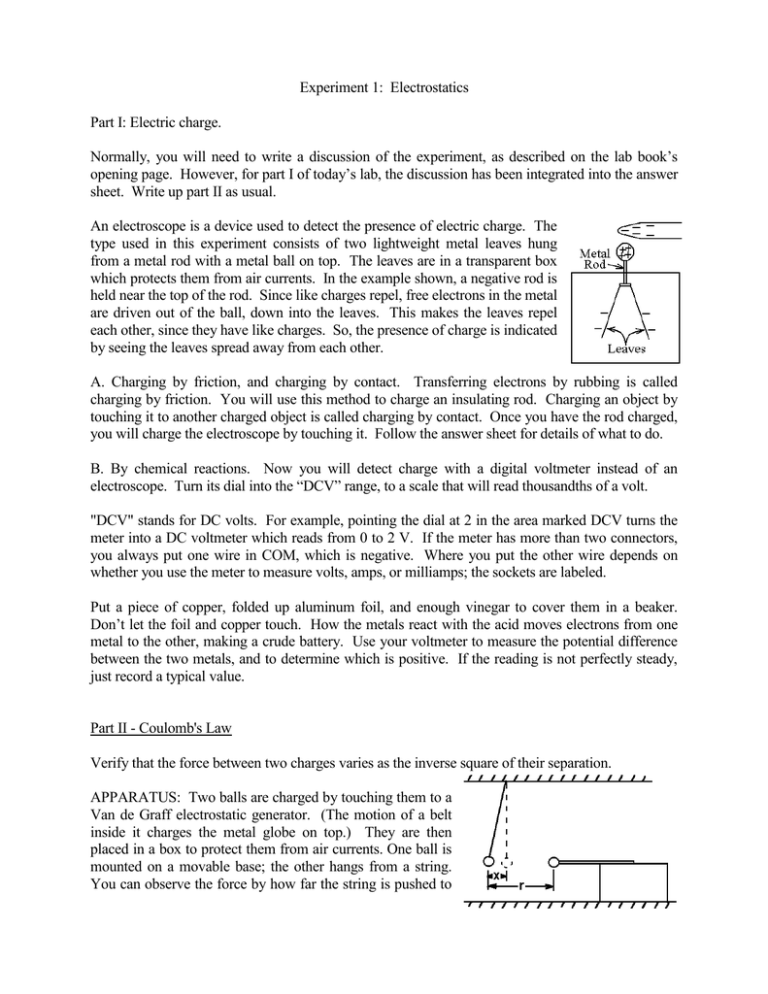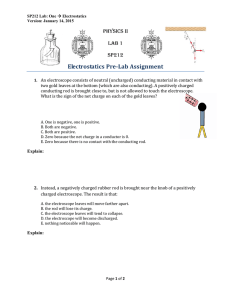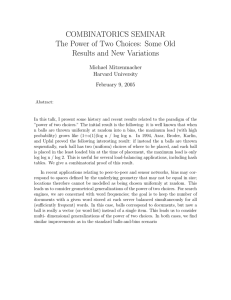Experiment 1: Electrostatics Part I: Electric charge.
advertisement

Experiment 1: Electrostatics Part I: Electric charge. Normally, you will need to write a discussion of the experiment, as described on the lab book’s opening page. However, for part I of today’s lab, the discussion has been integrated into the answer sheet. Write up part II as usual. An electroscope is a device used to detect the presence of electric charge. The type used in this experiment consists of two lightweight metal leaves hung from a metal rod with a metal ball on top. The leaves are in a transparent box which protects them from air currents. In the example shown, a negative rod is held near the top of the rod. Since like charges repel, free electrons in the metal are driven out of the ball, down into the leaves. This makes the leaves repel each other, since they have like charges. So, the presence of charge is indicated by seeing the leaves spread away from each other. A. Charging by friction, and charging by contact. Transferring electrons by rubbing is called charging by friction. You will use this method to charge an insulating rod. Charging an object by touching it to another charged object is called charging by contact. Once you have the rod charged, you will charge the electroscope by touching it. Follow the answer sheet for details of what to do. B. By chemical reactions. Now you will detect charge with a digital voltmeter instead of an electroscope. Turn its dial into the “DCV” range, to a scale that will read thousandths of a volt. "DCV" stands for DC volts. For example, pointing the dial at 2 in the area marked DCV turns the meter into a DC voltmeter which reads from 0 to 2 V. If the meter has more than two connectors, you always put one wire in COM, which is negative. Where you put the other wire depends on whether you use the meter to measure volts, amps, or milliamps; the sockets are labeled. Put a piece of copper, folded up aluminum foil, and enough vinegar to cover them in a beaker. Don’t let the foil and copper touch. How the metals react with the acid moves electrons from one metal to the other, making a crude battery. Use your voltmeter to measure the potential difference between the two metals, and to determine which is positive. If the reading is not perfectly steady, just record a typical value. Part II - Coulomb's Law Verify that the force between two charges varies as the inverse square of their separation. APPARATUS: Two balls are charged by touching them to a Van de Graff electrostatic generator. (The motion of a belt inside it charges the metal globe on top.) They are then placed in a box to protect them from air currents. One ball is mounted on a movable base; the other hangs from a string. You can observe the force by how far the string is pushed to the side, x. This force is plotted against the separation of the balls, r, on log-log graph paper. The slope of this plot is equal to n in rn; that is, the slope is the power to which r is being raised. This is compared to what appears in Coulomb’s law. PROCEDURE: (Place the box right under an overhead for best illumination of the ruler. If the box has gotten out of square in storage, set weights at its corners to hold it in shape.) 1. Run the Van de Graff for a second or two by plugging it in. Charge the balls by touching them to the globe, running the machine between balls. If they now touch you, the box, or anything else, the charge will escape. 2. Put the hanging ball in the box. There is a mirror just above a ruler on the box’s back wall. Adjust the hanging ball’s height so it is partly in front of the ruler and partly in front of the mirror, as shown. With the other ball outside, position the hanging ball so that its left side is at 15.0 cm on the ruler. The left side should line up with its reflection each time you read either ball's position so that your eye is in the correct place. Cover the top of the box with old transparencies. Be careful not to bump the box after this, or you might change the 15.0 cm. 3. Slide the movable ball into the box. If the balls are sufficiently charged, the hanging one should be displaced over 2 cm when the other is close to it. 4. Record the positions of both balls, at 1 cm intervals as you slide the ball from 26 cm to 18 cm. IT’S NOT UNUSUAL TO HAVE TO DO THIS OVER. SO: Before each reading, check that the balls are lined up parallel to the ruler. Have other members of the group check some data to be sure it is being read correctly: Put your head where one ball is in front of its reflection, take the reading, put your head where the other ball is in front of its reflection, take the other reading. Read to the nearest 0.1 cm. Do not take data with the sliding ball's position, s, outside of the range 26> s > 18 cm. Further out, stray charge on the floor and walls of the box is nearly as close as the sliding ball. Farther in, the charge on the balls begins to polarize, superimposing an attractive force on top of the repulsion. CALCULATIONS & ANALYSIS: If the q1 and q2 remain constant, Coulomb’s law reduces to . Your objective is to measure n in F = arn to see if it comes out -2. Notice that if you plot log F as a function of log r, F = arn is a straight line whose slope is n: Take the log of both sides: log F = log (arn ) The log of a product is the sum of the logs: log F = log a + log rn Since log rn = n log r , So, you will plot this graph and determine its slope. If Coulomb’s law is wrong, the graph will not be a straight line, or its slope will not be -2. 1. Calculate x and r for each trial. Instead of measuring force in newtons or pounds, it's convenient to make up your own force unit, defined such that one unit of force causes one centimeter of displacement. This makes the force simply equal to x. 2. Graph the data on the log-log graph paper provided. Don’t punch up any logs; the graph paper does the logs for you. Draw what appears to be a best fit line through your data: One that passes as close as possible to as many points as possible. 3. Find its slope, measuring the rise and run with a ruler, not from your data or the scale of the graph. Measuring the logarithmic graph with the linear ruler is what takes the logs of F and r. Indicate which points on the line you measured between. Observe the following rules, which also apply to all future labs: - Find the slope from the best fit line, not from data points which lie off the line. (The line averages out some of the random errors in individual points.) - Find it from points near opposite ends of the line, not points near each other. (If little numbers are off a little, it makes more of a difference than if big numbers are off a little.) 4. Round n to the nearest integer - it's only good to one significant figure. In your conclusion, state whether your result agrees with Coulomb's. 5. After the instructor approves your results, put the hanging ball back in its container so it won't get lost. PHY 122 Report on Experiment 1 - Electrostatics Part I: Objective: To perform various demonstrations involving static electric charge. Apparatus: The electroscope consists of two metal leaves in a box which shields them from air currents. The leaves connect to a metal rod which protrudes through the box’s top. If they are charged via this rod, the leaves repel each other; the larger the charge, the farther apart they move. Procedure & Results: A. We rubbed the flat-ended black plastic rod with the white silk, then held it near the metal ball on top of the electroscope without touching it. We observed When the rod is taken away again, (What does the electroscope do?) We repeated this, except this time the rod was touched to the ball. After the rod is removed, We charged the rod by rubbing it on the silk again. When brought near the charged electroscope without touching it, We repeated this, except this time with the pointed rod, after rubbing it with the blue cloth. (What does the electroscope do?) Show why on the following pictures: Let’s say the electroscope has ten units of charge on it as shown in the first picture. Complete the other two pictures, showing on each - The position of the leaves - How those ten plus signs have been redistributed. So, why did the leaves do what you showed in the middle picture? Why did the leaves do what you showed on the right? We turned on a faucet just enough for a stream of water that breaks up into drops after a few inches. A charged rod was held near the stream of water, without touching it. (Sketch what you see. Charges in the water are attracted or repelled by the rod. Indicate on your sketch which side of the stream is + and which side is -. Then, explain why the stream does what you saw.) B. Some copper and aluminum foil were placed in vinegar. The digital meter showed ____________ V between them, with ______________ (which metal?) positive. PART II: H (hanging ball) S (sliding ball) r x = F Attach log F vs. log r graph. Calculate n: So, your result is that the force is proportional to r to the ________ power. (Round to nearest integer.)




